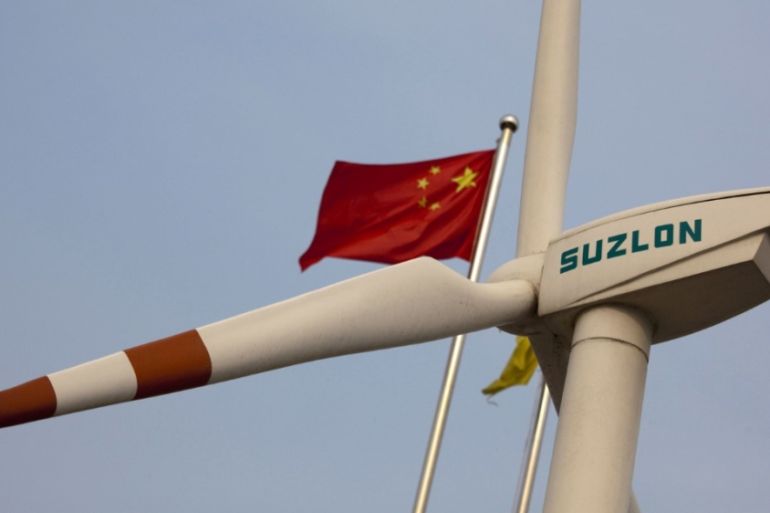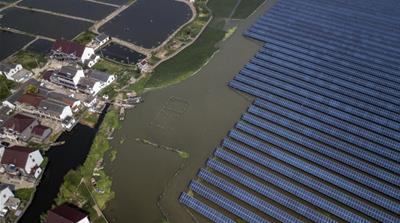Powering China: Tough choices for Beijing as oil questions linger
Instability in the Middle East may be forcing China to rethink its energy supply mix.

Shenzhen, China – Months of increasingly violent protests in Hong Kong; a trade war with the United States; an epidemic that has brought the pork industry to its knees; and a slowing global economy.
With all these challenges, the last thing that China – the world’s top oil importer – needs right now is a higher imported fuel bill.
Keep reading
list of 4 itemsBehind India’s Manipur conflict: A tale of drugs, armed groups and politics
China’s economy beats expectations, growing 5.3 percent in first quarter
Inside the pressures facing Quebec’s billion-dollar maple syrup industry
A record 14 percent surge in oil prices on September 16 – following drone attacks on Saudi Arabian oil refineries – served to underscore China’s reliance on imported energy, and the importance of its plan to diversify its energy sources.
The missile attacks of October 11 on an Iranian oil tanker that caused a 2.4 percent jump in oil prices – the sharpest since the Gulf War in 1990 – and the prospect of broader unrest throughout the Middle East now that Turkey has moved forces into Kurdish areas of Syria, are only likely to heighten China’s unease, analysts say.
“The increase in oil prices will clearly raise the cost of imported crude supply for Chinese refineries, possibly followed by dislocating effects further down the value chain, like the transportation sector, heating sector and consumer goods that use oil as a feedstock,” Julian Inchauspe and Roberto Aguilera, energy economists at Curtin University in Perth, Australia told Al Jazeera.
“In some cases, it will be possible to substitute to other fuels like natural gas and coal, which will boost prices of those commodities,” they said in a joint response.
After the surge in prices following the attacks on Saudi Arabia, prices fell almost as quickly once the government signalled oil production would be back online in a matter of weeks. And despite further falls in recent days, Brent crude oil prices are still nearly 10 percent higher than they were at the start of 2019.
On Friday, China’s Premier Li Keqiang held a special meeting with top energy officials stressing the need to maintain energy security amid rising global tensions and the country’s supply challenges.
Li said China needed to further tap its own coal resources, boost domestic gas and oil exploration, and push for more hydropower, wind and solar energy to diversify its energy sources.
Here comes the sun
All of those options come with pros and cons. But in the long term, analysts say, China appears to have little choice but to give renewables a major boost.
While domestically produced coal gives China a valuable energy security buffer, over-reliance on it has in recent years resulted in choking smog in some of its biggest cities. Oil and gas, whether imported or domestically sourced, also contribute to pollution.
Meanwhile, imported oil and gas, as witnessed by recent events, expose China to overseas developments over which Beijing has little control.
Nuclear power generates large amounts of toxic waste that can take hundreds of years to degrade, while hydroelectric projects displace entire communities and ecosystems.
Oil giant BP said China accounted for 24 percent of the world’s energy consumption last year, the biggest share of any country.
As of 2017, most of that energy, around 60 percent, came from coal. Oil contributed another 19 percent, and gas another seven percent. Renewables accounted for around three percent, according to BP.
That picture is set to change.

BP’s projections show renewables rising in importance, supplying 18 percent of China’s energy by 2040, the same proportion as oil by then. The proportion of gas will likely double from seven percent in 2017 to 14 percent by 2040. Meanwhile, coal’s share will fall to 35 percent.
While the Middle Kingdom has been a leader in installing solar and wind power in recent years, new policies removing subsidies for renewable projects have started to slow the implementation of such projects.
Even with all the recent installations, wind and solar only accounted for 5.2 percent and 2.5 percent respectively of China’s national power generation in 2018, according to data from the China National Energy Administration. So there is substantial room for growth in renewable energy, analysts say.
“Globally, everyone is looking at higher oil prices and a higher energy bill,” James Dorsey, a senior fellow at the S Rajaratnam School of International Studies in Singapore, told Al Jazeera. “To what degree that propels China to look at other alternatives, more renewables, more gas, theoretically this could be an incentive.”
Oil dependent
But right now, imported oil remains crucially important for China’s economy.
According to Yujiao Lei, a consultant at energy research firm Wood Mackenzie, Saudi Arabia accounts for more than 15 percent of China’s crude imports. And Chinese customs data show that Saudi Arabia is the largest single source of China’s crude oil.
Saudi Arabia had stepped up its exports to China in recent months to fill a gap left by Iran. In May, the US said it would not renew waivers issued to several countries, including China, that allowed them to continue importing Iranian oil while under US sanctions.
Geopolitical uncertainty and the possibility of further strikes, or retaliation against Iran – which China has also been wooing for energy supplies despite US sanctions – could keep prices elevated, further disrupting China’s supplies, analysts say.

China’s state-run media coverage has largely attempted to downplay the attacks’ impact on China, with the Global Times newspaper reporting on September 17 that China could tap into its 90-day strategic oil reserve to stabilise prices in the near term.
“The possibility of a more substantial future disruption has to be a concern for Beijing,” Jonathan Fulton, a political scientist in the Gulf region told Al Jazeera.
Dorsey said the attacks highlighted the vulnerability of Saudi Arabia’s oil assets. He added that those concerns would remain as long as it continued to wage war in Yemen, also leaving China vulnerable to associated risks.
“More fundamentally, there are voices that are suggesting China may have to further diversify their sources of fossil fuels,” Dorsey said. “The problem is where do you go?” he asked.
The gas solution
The natural gas market could give China more options for sourcing energy from more stable parts of the world.
China has already announced plans to increase natural gas usage by 60 percent by 2023,
“In some ways, the US would be a logical asset, but with the trade war and the decoupling of the economies, diversification would be easier said than done,” Dorsey said.
The US is set to become a net exporter of oil and gas by next year, according to the US Energy Information Administration.
A China-US trade deal, which could bolster US President Donald Trump’s 2020 re-election ambitions, could also be an avenue for China to ease its energy supply constraints.
But the interim trade deal struck between the US and China on Friday does not appear to contain any agreements on boosting natural gas imports to China, and full details of the agreement are not expected to be finalised by mid-November when the Asia-Pacific Economic Cooperation summit takes place in Chile.
“American liquefied natural gas exporters have been especially hurt by the trade war – China is the second-largest importer of LNG and that’s been set to increase as it tries to move away from coal-fired power plants,” Fulton said.
A solution to China’s problem may lie much closer to home.
Consultancy firm McKinsey says that around 70 percent of the world’s new LNG production capacity over the next three years will be in the US and Australia, putting the latter in a strong position to benefit from the growing demand in China.
In fact, China’s growth in demand for LNG is already mostly being served by Australia, according to McKinsey.
Another potential source of abundant natural gas for China is Russia, a close political ally.
The Chinese Premier Li was in Russia on September 18, four days after the attacks on Saudi oil facilities, talking about energy infrastructure and other deals with Russian Prime Minister Dmitry Medvedev.
Gas imports from Qatar are also likely to increase, according to Fulton.